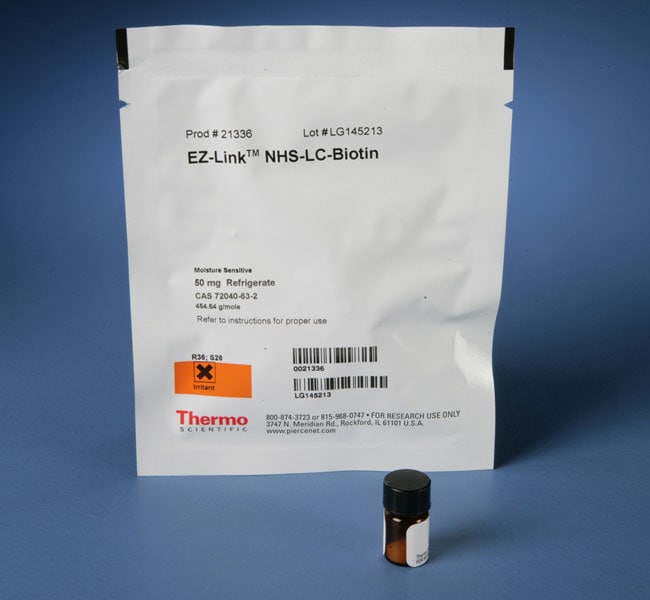Search Thermo Fisher Scientific

카탈로그 번호
21336
제품 사이즈
50 mg
제품 정가(KRW)
제품 정가 275,000
온라인 행사 234,000
(01-Oct-2024에 종료)
공급가
재고 정보
-
수량
| 카탈로그 번호 | 제품 사이즈 | 제품 정가(KRW) | 재고 정보 | 수량 | |
|---|---|---|---|---|---|
| 21336 | 50 mg | 제품 정가 275,000 온라인 행사 234,000 (01-Oct-2024에 종료) 공급가 | - |
제품 개요
그림
동영상
관련 제품 추천
관련 제품 추천
문서
FAQ
인용 및 참조 문헌
추가 정보
관련 제품 추천
Thermo Scientific EZ-Link NHS-LC-Biotin is a long-chain, NHS-ester activated biotinylation reagent for labeling primary amines (e.g., protein lysines), whose membrane permeability enables it to be used for general intracellular labeling.
Features of EZ-Link NHS-LC-Biotin:
• Protein labeling—biotinylate antibodies or other proteins for detection or purification using streptavidin probes or resins
• Membrane-permeable—can be used to label inside cells (intracellular)
• Amine-reactive—reacts with primary amines (-NH2), such as the side-chain of lysines (K) or the amino-termini of polypeptides
• Irreversible—forms permanent amide bonds; spacer arm cannot be cleaved
• Solubility—must be dissolved in DMSO or DMF before further dilution in aqueous buffers
• Medium length—spacer arm (total length added to target) is 22.4 angstroms; it consists of the biotin valeric acid group extended by a 6-atom chain
NHS-LC-Biotin is succinimidyl-6-(biotinamido)hexanoate. It is one of three similar EZ-Link NHS-Biotin Reagents that enable simple and efficient biotinylation of antibodies, proteins and any other primary amine-containing biomolecules in solution. Differing only in their spacer arm lengths, the three NHS-ester reagents offer researchers the possibility of optimizing labeling and detection experiments where steric hindrance of biotin binding is an important factor. Because they are uncharged and contain simple alkyl-chain spacer arms, these biotin compounds are membrane-permeable and useful for intracellular labeling.
We manufacture biotin reagents to ensure the highest possible overall product integrity, consistency and performance for the intended research applications.
N-Hydroxysulfosuccinimide (NHS) esters of biotin are the most popular type of biotinylation reagent. NHS-activated biotins react efficiently with primary amino groups (-NH2) in alkaline buffers to form stable amide bonds. Proteins (e.g., antibodies) typically have several primary amines that are available as targets for labeling, including the side chain of lysine (K) residues and the N-terminus of each polypeptide.
Varieties of biotin NHS-ester reagents differ in length, solubility, cell permeability and cleavability. Non-sulfonated NHS-biotins are cell permeable but must be dissolved in organic solvent such as DMSO or DMF. Sulfo-NHS biotins (and those with pegylated spacers) are directly water soluble but not membrane permeable. Varieties containing disulfide bonds can be cleaved using reducing agents, enabling the biotin group to be disconnected from the labeled protein.
Features of EZ-Link NHS-LC-Biotin:
• Protein labeling—biotinylate antibodies or other proteins for detection or purification using streptavidin probes or resins
• Membrane-permeable—can be used to label inside cells (intracellular)
• Amine-reactive—reacts with primary amines (-NH2), such as the side-chain of lysines (K) or the amino-termini of polypeptides
• Irreversible—forms permanent amide bonds; spacer arm cannot be cleaved
• Solubility—must be dissolved in DMSO or DMF before further dilution in aqueous buffers
• Medium length—spacer arm (total length added to target) is 22.4 angstroms; it consists of the biotin valeric acid group extended by a 6-atom chain
NHS-LC-Biotin is succinimidyl-6-(biotinamido)hexanoate. It is one of three similar EZ-Link NHS-Biotin Reagents that enable simple and efficient biotinylation of antibodies, proteins and any other primary amine-containing biomolecules in solution. Differing only in their spacer arm lengths, the three NHS-ester reagents offer researchers the possibility of optimizing labeling and detection experiments where steric hindrance of biotin binding is an important factor. Because they are uncharged and contain simple alkyl-chain spacer arms, these biotin compounds are membrane-permeable and useful for intracellular labeling.
We manufacture biotin reagents to ensure the highest possible overall product integrity, consistency and performance for the intended research applications.
N-Hydroxysulfosuccinimide (NHS) esters of biotin are the most popular type of biotinylation reagent. NHS-activated biotins react efficiently with primary amino groups (-NH2) in alkaline buffers to form stable amide bonds. Proteins (e.g., antibodies) typically have several primary amines that are available as targets for labeling, including the side chain of lysine (K) residues and the N-terminus of each polypeptide.
Varieties of biotin NHS-ester reagents differ in length, solubility, cell permeability and cleavability. Non-sulfonated NHS-biotins are cell permeable but must be dissolved in organic solvent such as DMSO or DMF. Sulfo-NHS biotins (and those with pegylated spacers) are directly water soluble but not membrane permeable. Varieties containing disulfide bonds can be cleaved using reducing agents, enabling the biotin group to be disconnected from the labeled protein.
For Research Use Only. Not for use in diagnostic procedures.
사양
제품 유형
NHS-LC-Biotin
수량
50 mg
제품라인
EZ-Link™
세포 투과성
Cell-Permeant
화학물질 반응성
Amine
반응성 부분
Active Ester, Succinimidyl Ester, NHS Ester
용해도
DMF (Dimethylformamide), DMSO (Dimethylsulfoxide)
라벨 또는 염료
Biotin
스페이서
Mid-length
라벨 유형
Biotin & Analogs
구성 및 보관
Store desiccated at 4°C. Shipped at ambient temperature.
그림
문서 및 다운로드
Certificates | 증명서
Lot 번호 또는 부분 Lot 번호로 검색하십시오.
자주 묻는 질문(FAQ)
인용 및 참조 문헌
Search citations by name, author, journal title or abstract text